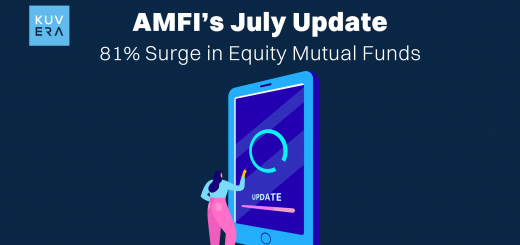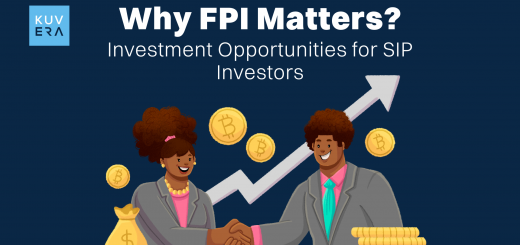Last year, when the markets were booming, there was an unending buzz around investing in mutual fund returns.
You might have seen stock market returns and mutual fund returns flashing on every news channel. But this rosy picture of wealth creation was soon crumpled with the bear territory entering the picture. Soon, the markets red and portfolio picturing financial goals as a distant dream.
But here’s a truth often overlooked. Did you know that raw returns tell only part of the story?
To truly understand how well your investment is performing, you need to dig deeper, to move beyond the surface and explore the world of ratios. You can think of them as the diagnostic tools in a financial doctor’s kit, revealing the underlying health of your mutual fund.
You can consider two funds, both claiming similar returns. One might have achieved this through aggressive risk-taking, while the other might have maintained a steadier and more controlled approach.
Which one of the funds align better with your appetite for risk?
That is where ratios come in. They can provide context, allowing you to make informed decisions for mutual funds investing. They can also help you avoid potentially costly investment mistakes.
So, let us look into the key ratios that can help you assess mutual funds India with clarity and confidence.
1. The Sharpe Ratio: Risk-Adjusted Returns
The Sharpe ratio is arguably the most widely used metric for evaluating risk-adjusted returns. It answers a crucial question: how much extra return are you getting for the extra risk you’re taking? It measures the excess return earned per unit of total risk.
- How it works: The Sharpe ratio subtracts the risk-free rate of return (like the return on government bonds) from the fund’s return and divides the result by the fund’s standard deviation (a measure of volatility).
- What it tells you: A higher Sharpe ratio indicates better risk-adjusted performance. A fund with a high Sharpe ratio has delivered strong returns without excessive volatility. Conversely, a low Sharpe ratio suggests that the fund’s returns haven’t adequately compensated for the risk taken.
- Why it matters: It helps you compare funds with different risk profiles on a level playing field. If you are looking for a good risk adjusted return, this ratio is a must know.
2. The Sortino Ratio: Downside Risk Focus
While the Sharpe ratio considers total risk, the Sortino ratio focuses specifically on downside risk, or the risk of negative returns. This is particularly relevant for investors who are more concerned about protecting their capital from losses.
- How it works: The Sortino ratio is similar to the Sharpe ratio, but it uses downside deviation instead of standard deviation. Downside deviation measures only the volatility of negative returns.
- What it tells you: A higher Sortino ratio indicates better performance in terms of managing downside risk. It suggests that the fund has delivered strong returns without exposing investors to excessive losses during market downturns.
- Why it matters: If you’re a conservative investor or approaching retirement, the Sortino ratio can be a valuable tool for assessing a fund’s ability to protect your capital.
3. The Treynor Ratio: Systematic Risk Assessment
The Treynor ratio measures the excess return earned per unit of systematic risk, also known as beta. Beta represents a fund’s sensitivity to market movements.
- How it works: The Treynor ratio subtracts the risk-free rate of return from the fund’s return and divides the result by the fund’s beta.
- What it tells you: A higher Treynor ratio indicates better performance in terms of generating returns relative to systematic risk. It suggests that the fund has delivered strong returns without taking on excessive market risk.
- Why it matters: The Treynor ratio is particularly useful for evaluating diversified portfolios, as it focuses on the risk that cannot be diversified away.
4. Alpha: Outperforming the Market
Alpha measures a fund’s ability to generate returns above and beyond what would be expected based on its beta. It essentially represents the fund manager’s skill in generating excess returns.
- How it works: Alpha is calculated by comparing a fund’s actual return to its expected return based on its beta and the market return.
- What it tells you: A positive alpha indicates that the fund has outperformed its benchmark, while a negative alpha suggests underperformance.
- Why it matters: Alpha is a key indicator of a fund manager’s ability to add value. A high alpha suggests that the manager has made successful investment decisions.
5. Expense Ratio: Cost Matters
While not a performance ratio in the traditional sense, the expense ratio is a crucial factor to consider. It represents the annual cost of managing the fund, expressed as a percentage of the fund’s assets.
- How it works: The expense ratio includes management fees, administrative expenses, and other operating costs.
- What it tells you: A lower expense ratio means that more of your investment goes towards generating returns.
- Why it matters: High expense ratios can eat into your returns over time. Even a small difference in expense ratios can have a significant impact on your long-term wealth. When considering passive investing with mutual fund, expense ratios are especially important.
Ratios and Asset Classes: A Tailored Approach
It is important to note that different ratios may be more relevant for different asset classes. For example:
- For equity funds, the Sharpe, Sortino, and Treynor ratios, as well as alpha, are particularly important.
- For debt funds, the expense ratio and measures of credit risk are more relevant.
- For hybrid funds, a balanced evaluation of both equity and debt related ratios is required.
Beyond the Numbers: Qualitative Factors
While ratios provide valuable insights, they shouldn’t be the sole basis for your investment decisions. Consider qualitative factors as well, such as:
- The fund manager’s experience and track record
- The fund’s investment philosophy and strategy
- The fund’s consistency of performance over time
- The overall economic outlook.
Taking Action: Start SIP Now
Understanding these ratios empowers you to make informed decisions and build a robust investment portfolio. If you have not already, you can consider to start SIP now. SIP investing can allow you to invest regularly, regardless of market conditions, and benefit from the power of compounding. Mutual fund SIP can allow for systematic investment, and can provide a disciplined approach to wealth creation.
Wrapping Up
Investors should not let the complexity of mutual fund evaluation intimidate you. You can gain a deeper understanding of fund performance and make informed investment decisions by understanding and applying these key ratios. You need to remember that mutual fund returns are only one piece of the puzzle. You can build a portfolio that aligns with your financial goals and risk appetite by considering risk-adjusted returns, downside risk, and other important factors. Ultimately, a well-rounded and informed approach can lead to long-term investment success.
Interested in how we think about the markets?
Read more: Zen And The Art Of Investing
Watch here: Learn about the F&O craze in India












